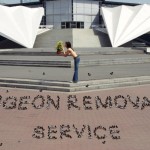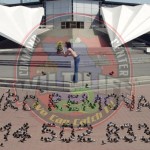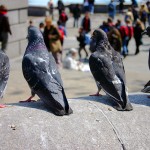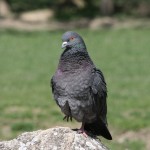Commercial Industrial Pigeon Removal Control St Louis Missouri
PIGEON REMOVAL
Commencing from a pigeon’s viewpoint, city living isn’t too trashy. Food and water are enthusiastically available. Predators are rare. There’s also plenty of free housing. Pigeons find our window ledges, rooftops, bridges, and warehouses to be ideal substitutes for the natural ledges in cliff sides that they have always used as roosting, nesting, and sheltering sites. When flocks grow too large and become a nuisance, killing the birds is often the first plan of action. But killing pigeons won’t save you the troubles, and there are better, non- lethal ways to fix a pigeon problem. Contacting an expert like Michael E Beran Master Falconer St Louis, Missouri 314-502-8339 would be a good move.
Michael E Beran
beran.michael@gmail.com
314-502-8339
Conflicts between pigeons and humans have increased as the populations of both have grown. The feral pigeon is the species most often blamed for causing problems in urban areas throughout the world with their droppings that deface buildings and increase the cost of maintenance. Lethal control techniques can be used to reduce pigeon numbers; however, this is usually only a short term solution as removed pigeons are quickly replaced by juvenile birds and the flock can become larger than the initial size. With any lethal control method, animal welfare issues need to be considered and addressed; for example, removing adult pigeons can leave juvenile flightless birds in nests to die of starvation. If you have a pigeon problem, there are many techniques that can be used to reduce or remove the population. Implementing non-lethal control techniques will provide the most effective long term results. The best way to minimize or prevent the nuisance caused by feral pigeons is to control where they roost, nest and feed.

Falconry Based Pigeon Removal Service
You may actually needs several techniques, probably one, two or even three of these methods to deal with those nuisance in your domain.

Pigeon Bird Removal Control
Eliminate food sources: The most effective way of dispiriting feral pigeons from infesting houses and public areas is to not feed them and remove any potential food source (e.g. pet food).The number of pigeons in an area is determined by the availability of a sustainable food supply. A plentiful food supply encourages year round breeding; therefore, the removal of the food source will result in less breeding and will also encourage the pigeons to move to another location.
Resistant: Pigeon proofing your building will prevent pigeons from gaining access to potential nesting or roosting sites. This includes sealing any gaps into buildings and under eaves with mesh or wooden panels, or with more extensive renovations. Pigeons commonly perch on sites such as eaves,
Trapping: Pigeons caught and killed by trapping can be replaced by new populations rapidly. As with any control technique, the source of food must be removed otherwise trapping may have minimal effect in reducing pigeon numbers, however combined with Falconry, trapping is a critical part of the program

Falconry Based Pigeon Removal Control
Shooting: A licensed pest controller will assess each situation and determine if shooting is a suitable option. Retrieval of the pigeons may not always be possible, so it is important that shots are accurate to achieve a quick kill and prevent birds suffering unnecessarily.
Poisoning: This process must be carried out by licensed pest control operators. A painless narcotic (alpha-chloralose) is added to the food source and, once consumed, causes the birds to overdose and go to sleep. The birds should, in theory, consume the narcotic and sit and wait to be picked up; however, some birds may feed and fly off, and as a result can die an inhumane death. The poison is not specific to pigeons and consequently other non-target birds may be affected.
Problems and Health Risks
The presence of pigeons can result in a range of problems. They attract ticks, cockroaches and rats. They cause damage to buildings and monuments, due to the highly corrosive nature of acid in pigeon droppings. Also damages to properties by pigeons roosting/breeding in roof spaces rolled steel joists and inside factory units. Debris from roosting flocks building up, causing gutters and drains to block, damage to roofs and other structures, and creating potential fire hazards. Extensive damage to air-conditioning units and other roof top machinery. Hygiene concerns due to pigeon droppings in/on industrial, commercial, and domestic buildings. They simply provide a vector for the introduction of weeds and disease. Their presence increases the risk of disease and parasite transmission between feral, domestic and seabird populations. Escalating costs through public liability insurance from slipping on dropping build up. I’m pretty sure you don’t want to be prone to all these risks, why not contact the professional Michael E Beran Master Falconer St Louis, Missouri 314-502-8339.

Falconry Based Pigeon Removal Control
Killing, by any means, isn’t just cruel; it fails to solve the root cause of the problem, leading to an endless cycle of killing. Using any form of pigeon removal means most especially chemicals and birds repellant won’t help you a bit. A bird who consumes these chemicals die ridiculously and the sight of such cruel killings won’t do your little kids who tend to care for them any good. Taking a small subset out of the population really doesn’t accomplish much other than opening up niche space for other birds to fill. The end result of the use of Avitrol or other lethal pigeon control methods is an endless cycle of unnecessary killing. Save yourself the stress and worries, just contact Michael E Beran Master Falconer St Louis, Missouri 314-502-8339 to give you the very best of customer satisfaction in this field.
Commercial Industrial Pigeon Removal Control St Louis Missouri



